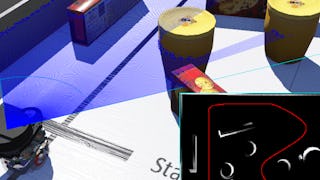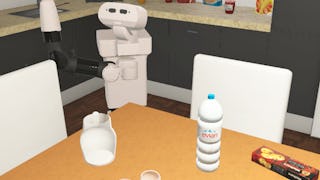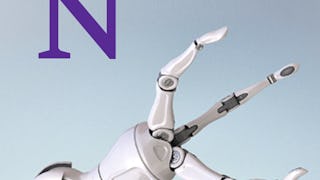"Basic Robotic Behaviors and Odometry" provides you with an introduction to autonomous mobile robots, including forward kinematics (“odometry”), basic sensors and actuators, and simple reactive behavior. This course is centered around exercises in the realistic, physics-based simulator, “Webots”, where you will experiment in a hands-on manner with simple reactive behaviors for collision avoidance and line following, state machines, and basic forward kinematics of non-holonomic systems. An overarching objective of this course is to understand the role of the physical system on algorithm design and its role as source of uncertainty that makes robots non-deterministic. If you are interested in getting started with robotics, this course is for you!
通过 Coursera Plus 解锁访问 10,000 多门课程。开始 7 天免费试用。

您将学到什么
Model mechanisms, sensors and actuators in a physics-based online simulator.
Understand basic reactive and discrete controllers.
Perform forward kinematics computations for simple (non-)Holonomic mechanisms.
您将获得的技能
要了解的详细信息

添加到您的领英档案
13 项作业
了解顶级公司的员工如何掌握热门技能

积累特定领域的专业知识
- 向行业专家学习新概念
- 获得对主题或工具的基础理解
- 通过实践项目培养工作相关技能
- 获得可共享的职业证书

该课程共有5个模块
Welcome to Basic Robotic Behaviors and Odometry. This week introduces the course and gives you an opportunity to introduce yourself. You will prepare for the rest of the course by learning about the main operation tool we will use throughout, the realistic robotics simulator "Webots". You will become familiar with Webots, its hosting website, and will begin to develop your foundation in navigating the simulator.
涵盖的内容
9个视频9篇阅读材料3个作业1个讨论话题1个插件
This week introduces the devices that allow robots to move and effectuate changes in their environment ("actuators"), as well as perceive their world ("sensors").
涵盖的内容
5个视频9篇阅读材料4个作业
In this week, you will experiment with basic reactive robotic behaviors and understand the challenges of task execution.
涵盖的内容
5个视频1篇阅读材料1个作业1次同伴评审
This week you will learn how to formally describe the global pose of a robot and how different actuators can affect this pose.
涵盖的内容
7个视频1篇阅读材料3个作业
In this week, you will learn how to keep track of actuation commands and hence estimate the pose of your robot. You will use information from the environment to improve pose estimation and understand the concept of "holonomy".
涵盖的内容
4个视频2个作业1次同伴评审
获得职业证书
将此证书添加到您的 LinkedIn 个人资料、简历或履历中。在社交媒体和绩效考核中分享。
攻读学位
课程 是 University of Colorado Boulder提供的以下学位课程的一部分。如果您被录取并注册,您已完成的课程可计入您的学位学习,您的学习进度也可随之转移。
位教师

从 Algorithms 浏览更多内容
 状态:免费试用
状态:免费试用University of Colorado Boulder
 状态:免费试用
状态:免费试用University of Colorado Boulder
 状态:免费试用
状态:免费试用Northwestern University
 状态:预览
状态:预览Siemens
人们为什么选择 Coursera 来帮助自己实现职业发展




学生评论
54 条评论
- 5 stars
70.37%
- 4 stars
16.66%
- 3 stars
3.70%
- 2 stars
1.85%
- 1 star
7.40%
显示 3/54 个
已于 Oct 3, 2023审阅
Coursera part of course worked well with little/no confusion.
常见问题
To access the course materials, assignments and to earn a Certificate, you will need to purchase the Certificate experience when you enroll in a course. You can try a Free Trial instead, or apply for Financial Aid. The course may offer 'Full Course, No Certificate' instead. This option lets you see all course materials, submit required assessments, and get a final grade. This also means that you will not be able to purchase a Certificate experience.
When you enroll in the course, you get access to all of the courses in the Specialization, and you earn a certificate when you complete the work. Your electronic Certificate will be added to your Accomplishments page - from there, you can print your Certificate or add it to your LinkedIn profile.
Yes. In select learning programs, you can apply for financial aid or a scholarship if you can’t afford the enrollment fee. If fin aid or scholarship is available for your learning program selection, you’ll find a link to apply on the description page.
更多问题
提供助学金,



